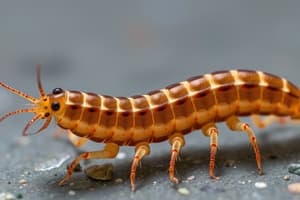Podcast
Questions and Answers
Les nématoïdes possèdent une cuticule épaisse principalement composée de chitine.
Les nématoïdes possèdent une cuticule épaisse principalement composée de chitine.
False (B)
Les Ascaris ont un appareil digestif bien développé chez l'adulte.
Les Ascaris ont un appareil digestif bien développé chez l'adulte.
True (A)
Tous les nématodes ont un système nerveux basé sur une structure épithéliale.
Tous les nématodes ont un système nerveux basé sur une structure épithéliale.
True (A)
Les Tardigrades se caractérisent par la présence de muscles longitudinaux pavés.
Les Tardigrades se caractérisent par la présence de muscles longitudinaux pavés.
Les Panarthropodes possèdent un hémocoèle et un système nerveux complexe.
Les Panarthropodes possèdent un hémocoèle et un système nerveux complexe.
Les nématoïdes sont exclusivement parasites.
Les nématoïdes sont exclusivement parasites.
Les Onychophores ont deux antennes segmentées et des glandes à glu sur la tête.
Les Onychophores ont deux antennes segmentées et des glandes à glu sur la tête.
Le gonochorisme est absent chez les nématodes.
Le gonochorisme est absent chez les nématodes.
Flashcards
Nématodes : caractéristiques générales
Nématodes : caractéristiques générales
Les nématodes sont des animaux vermiformes, libres ou parasites, avec une cuticule collagénique, des muscles longitudinaux, un système nerveux ectodermique et un cloaque. Ils ont des spermatozoïdes sans flagelle.
Caractéristiques des Ecdysozoaires (cuticule)
Caractéristiques des Ecdysozoaires (cuticule)
Les Ecdysozoaires possèdent une cuticule complexe en trois couches (épicuticule, exocuticule, endocuticule), sécrétée par des microvillosités de l'épiderme. Cette cuticule est souvent rigide et permet des mues.
Panarthropodes : squelette externe
Panarthropodes : squelette externe
Les Panarthropodes sont caractérisés par un squelette externe rigide et segmenté qui sert de support et de protection.
Onychophores : locomotion
Onychophores : locomotion
Signup and view all the flashcards
Tardigrades : cuticule
Tardigrades : cuticule
Signup and view all the flashcards
Nématomorphes : appareil digestif
Nématomorphes : appareil digestif
Signup and view all the flashcards
Nématodes : système nerveux
Nématodes : système nerveux
Signup and view all the flashcards
Eutélie : nématodes
Eutélie : nématodes
Signup and view all the flashcards
Study Notes
Ecdysozoaires
- Group of protostome animals characterized by ecdysis (molting)
- Include several phyla (e.g., Arthropoda, Nematoda)
Caractères dérivés (derived characteristics)
- Chitinous cuticle, three-layered: epicuticle, exocuticle, endocuticle
- Epicuticle secreted by microvilli of the epidermis
- Loss of locomotory cilia from epidermal cells
- Molting
- Terminal mouth position
Organisation schématique du tégument des Arthropodes
- Sensory seta (sensilla)
- Nerve fiber
- Epithelial cell
- Tormogen cell
- Nerve cell
- Glandular pore
- Cuticular spine
- Epicuticle
- Exocuticle
- Endocuticle
- Canalicular cell
- Nucleus
- Glandular cell
Nématodes
- Free-living or parasitic
- Body shape: threadlike, circular cross-section
- Thick cuticle, mostly collagenous
- Blastocoel cavity
- Longitudinal muscles only
- Ectodermal origin of nerve cords
- Cloaca
- Flagella-less sperm
Caractères généraux des Nématodes
- Fusiform body, tapered at both ends, often white
- Free-living or parasitic, ubiquitous
- Mouth surrounded by 3 to 6 lips
- Separate sexes
- Internal fertilization
- Direct development
Embranchement des Nématodes
- Approximately 25,000 species
- Include Platyhelminthes, Gastrotrichs, etc,
- Diverse group encompassing several other phyla
Ascaris
- Male and female anatomy depicted
- Diagram showing internal organs
- Mouth, esophagus, dorsal muscular chamber, ventral muscular chamber, intestine, rectum, anus
Systèmes excréteurs
- Tubular with rennet cells
- Basic-epithelial nervous systems
- Amphids, rings of sensory structures around mouth
- Separate sexes; direct development
- Constant number of cells and cell lineages per species (eutely)
Embranchement des Nématomorphes
- Extremely slender and long
- Larval stage is always parasitic on arthropods
- Atrophied or absent digestive system in adults
- Separate sexes; internal fertilization; metamorphosis
- Examples include Gordius aquaticus
Panarthropodes
- Segmented bodies with a hard exoskeleton
- Paired, non-fused appendages, often ending in claws
- Food intake via modified anterior appendages
- Dorsal vessel with lateral ostia
- Open circulatory system (hemocoel)
- Complex brain (protocerebro, 1 or 2 ganglions, tritocerebro)
Embranchement des Onychophores
- ~165 species
- Terrestrial
- One pair of lobopods per segment
Tardigrades
- Microscopic, aquatic, or terrestrial environments
- Four pairs of short, unjointed legs with claws
- Thin cuticle, often with scales, tubercles (hairs)
- Buccal stylets
- Separate sexes; direct development
- Cryptobiosis (extreme dormancy)
- Encystment (formation of protective cysts)
Studying That Suits You
Use AI to generate personalized quizzes and flashcards to suit your learning preferences.




